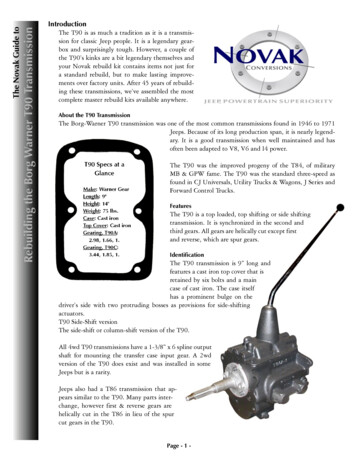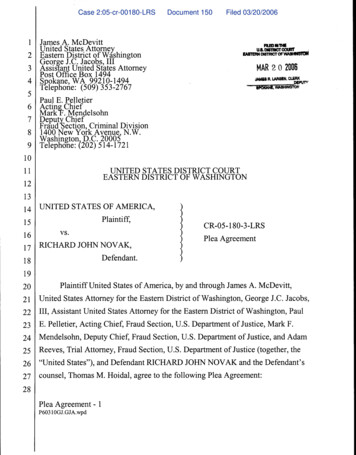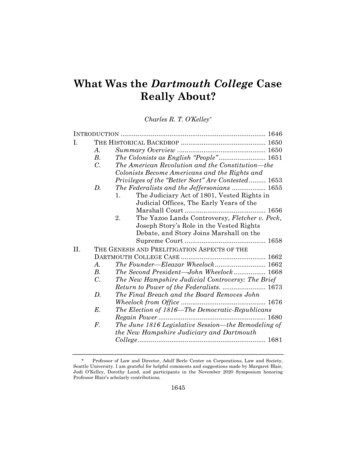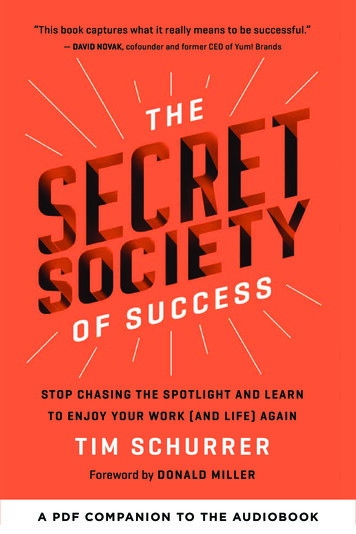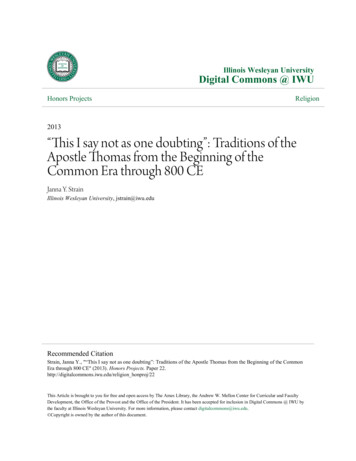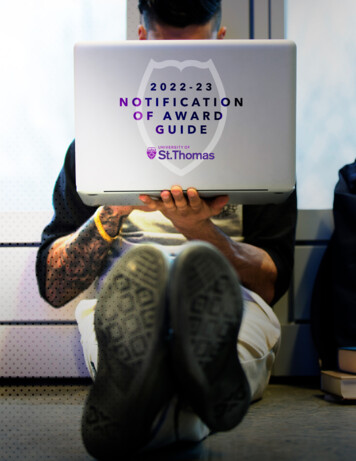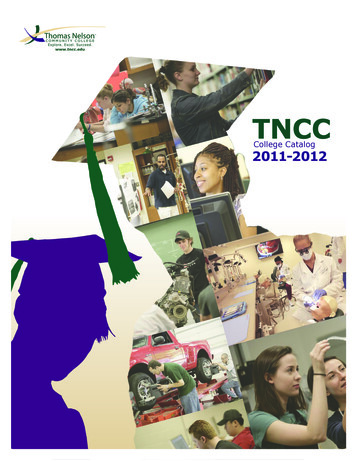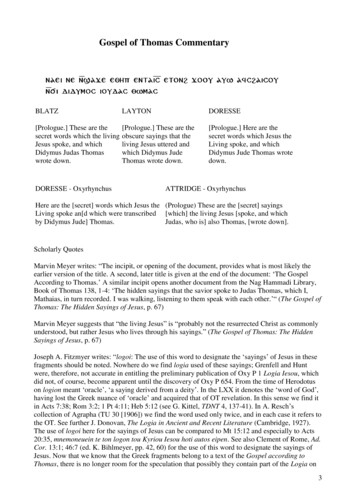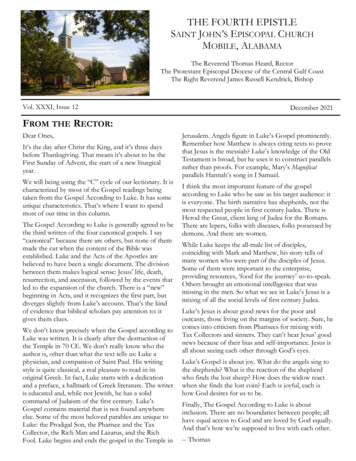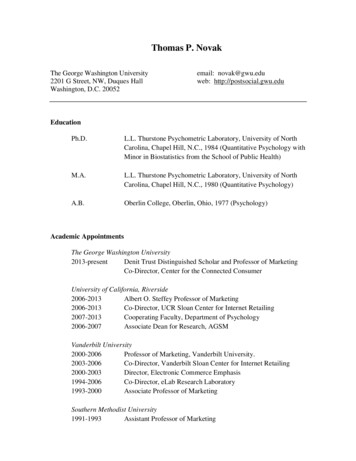
Transcription
Thomas P. NovakThe George Washington University2201 G Street, NW, Duques HallWashington, D.C. 20052email: novak@gwu.eduweb: http://postsocial.gwu.eduEducationPh.D.L.L. Thurstone Psychometric Laboratory, University of NorthCarolina, Chapel Hill, N.C., 1984 (Quantitative Psychology withMinor in Biostatistics from the School of Public Health)M.A.L.L. Thurstone Psychometric Laboratory, University of NorthCarolina, Chapel Hill, N.C., 1980 (Quantitative Psychology)A.B.Oberlin College, Oberlin, Ohio, 1977 (Psychology)Academic AppointmentsThe George Washington University2013-presentDenit Trust Distinguished Scholar and Professor of MarketingCo-Director, Center for the Connected ConsumerUniversity of California, Riverside2006-2013Albert O. Steffey Professor of Marketing2006-2013Co-Director, UCR Sloan Center for Internet Retailing2007-2013Cooperating Faculty, Department of Psychology2006-2007Associate Dean for Research, AGSMVanderbilt University2000-2006Professor of Marketing, Vanderbilt University.2003-2006Co-Director, Vanderbilt Sloan Center for Internet Retailing2000-2003Director, Electronic Commerce Emphasis1994-2006Co-Director, eLab Research Laboratory1993-2000Associate Professor of MarketingSouthern Methodist University1991-1993Assistant Professor of Marketing
VitaThomas P. NovakPage 2August 2018Visiting Academic AppointmentsThe University of Hong Kong (planned)January 2019Research Visiting Scholar, Faculty of Business and EconomicsUniversity of California, San DiegoSpring 2018Visiting Scholar, Rady School of ManagementFall 2013Visiting Scholar, Rady School of ManagementUniversity of Southern CaliforniaFall 2010Visiting Scholar, Annenberg School of CommunicationStanford University2000Visiting Scholar, Center for Electronic Business and Commerce1997Visiting Scholar, Department of MarketingColumbia University1989-1991Visiting Assistant Professor of MarketingUCLA1989Visiting Assistant Professor, Anderson Graduate School of Mgt.New York University1988-1989Visiting Assistant Professor of MarketingProfessional ExperienceInterval Research Corporation, Palo Alto, CA1995-1999Visiting Scholar (summer)Young & Rubicam, New York1983-1988Associate Research DirectorCarolina Population Center, Chapel Hill, N.C.1981-1982Research AssociateResearch Triangle Institute, N.C.1980 -1981Social Science AnalystNational Institutes for Mental Health, Washington, D.C.1977-1978Research Psychologist, St. Elizabeths Hospital
VitaThomas P. NovakPage 3August 2018Academic Honors and Awards2012University of Pennsylvania Future of Advertising Center/Wharton CustomerAnalytics Initiative “Innovative Approaches to Measuring AdvertisingEffectiveness” Winner for proposal “Crowdsourcing Ad Effectiveness: CanEmergent Segments Produce the Most Effective Online Ads? ( 7,500)2012Marketing Science Institute Ideas Challenge Winner for proposal “Idea Wars:Developing a Collaborative Research Agenda for the Gamification of Marketing”( 10,000)2012Finalist, Paul D. Converse Award for Outstanding Contributions to the Science ofMarketing.2011National Science Foundation Grant # IIS-1114828, “Motivations, Expectations andGoal Pursuit in Social Media,” Co-PI ( 413,756 for two years)2011Marketing Science Institute “Challenges of Communications and Branding in aDigital Era” research proposal competition winner ( 8,750)2011Robert D. Buzzell MSI Best Paper Award Honorable Mention for the “Right”Consumers for the Best Concepts: Identifying and Using Emergent Consumers inDeveloping New Products (Hoffman, Kopalle and Novak)2009Thomson Reuters’ Essential Science Indicators cited Professors Donna Hoffmanand Tom Novak’s Journal of Interactive Marketing (2009) article as a “FastBreaking Paper” (one of the most cited in the past two years) in the entire field ofEconomics and Business, November 2009.2009Google and WPP Marketing Research Awards Program, “Are Brand AttitudesContagious? Consumer Response to Organic Search Trends,” 55,000 (with DonnaL. Hoffman).2008Marketing Science Institute Research Award, “The ‘Right’ Consumers for the BestConcepts: A Methodology for Identifying Emergent Consumers for New ProductDevelopment,” 6,750 (with Donna L. Hoffman and Praveen Kopalle).2008Marketing Science Institute Research Award, “Consumer Research in VirtualWorlds: The Role of Context and Content on Response Accuracy,” 10,000 (withFrancesco Massara).2008Marketing Science Institute Visiting Scholar Sponsorship Award, 12,500(sponsoring Professor Francesco Massara, Università IULM, Milan, Italy.2008National Science Foundation, Global Environment for Network Innovations(GENI) End-User Opt-In Initiative.2005Sheth Foundation/Journal of Marketing Award for the article, “Marketing inComputer-Mediated Environments: Conceptual Foundations,” Journal ofMarketing 1996. This award is for long-term contributions to the discipline ofmarketing.
VitaThomas P. NovakPage 4August 20182005Stellner Distinguished Scholar for 2005-2006, University of Illinois at UrbanaChampaign2005MERLOT (Multimedia Educational Resource for Learning and Online Teaching)Business Classics Award for development of noncommercial learning resources.2004Member of Marketing Department ranked number two by Academic AssessmentServices (AAA) in research impact per faculty member (based on median citationrates) among the top 46 business schools in the United States.2003ISI Essential Science Indicators cited Professors Tom Novak and Donna Hoffman’sMarketing Science (2000) article as “Emerging Research Front” in the entire fieldof Economics and Business, December 2003.2003ISI Essential Science Indicators cited Professors Tom Novak and Donna Hoffmanfor the highest percentage increase in total citations in the entire field of Economicsand Business, July 2003.2002University of North Carolina Distinguished Graduate guished graduate.html)1999EDSF Excellence in Education Award for Innovation in Higher Education(sponsored by Xerox)1999With Professor Donna Hoffman, voted as one of the top two Internet scientists byover 600 U.S. and European scientists and marketing managers in a surveyconducted by the ProfNet Institute for Internet Marketing in Dortmund, Germany.1996TLS/SIRS Freedom of Information Award (www.sirs.com/freedom/tenn.htm)1993Honorable Mention, Marketing Science Institute Proposal Competition for UsingMarketing to Serve Society.Current Research Interests Consumer experience in the Internet of Things (IoT) Assemblage Theory Topological Data Analysis (TDA) and machine learning for visualization of IoTdata Anthropomorphism of smart devices Human-device interactivity in smart environments Self-extension and self-expansion theories Marketing strategy for post-social media environments
VitaThomas P. NovakPage 5August 2018Research Impact26,090 citations in Google Scholar (as of August 2018). Highly cited articleso 5 articles with 1000 citationso 12 articles with 500 citationso 25 articles with 100 citationsh-index 37i10-index 77Google Scholar Page: http://scholar.google.com/citations?hl en&user IK6 rNQAAAAJThe 1996 Journal of Marketing article on marketing in computer-mediated environments isthe most widely cited Journal of Marketing article from 1995-2007 and the #1 most citedpaper in the entire marketing discipline between 1990-2002 (Stremersch, Verniers andVerhoef 2007).The 2000 Marketing Science article on online customer experience is one of the “all timemost highly cited articles” and the top article in terms of “all time citations per year” inMarketing Science (Shugan 2008), as well as the 14th most cited paper in the entiremarketing discipline between 1990-2002 (Stremersch, Verniers and Verhoef 2007).Citations(August2018)Papers with over 200 Google Scholar Citations7424Hoffman and Novak (Journal of Marketing 1996)"Marketing in Hypermedia Computer-Mediated Environments”3408Novak, Hoffman, and Yung (Marketing Science 2000)“Measuring the Customer Experience in Online Environments”2878Hoffman, Novak, and Peralta (Communications of the ACM 1999)“Building Consumer Trust Online”1352Hoffman, Novak, and Chatterjee (JCMC 1995)"Commercial Scenarios for the Web: Opportunities & Challenges"1086Hoffman and Novak (The Information Society 1997)"A New Marketing Paradigm for Electronic Commerce"761Hoffman and Novak (Science 1998)"Bridging the Racial Divide on the Internet"755Hoffman, Novak and Peralta (The Information Society 1999)“Information Privacy in the Marketspace”731Novak, Hoffman, and Duhachek (Journal of Consumer Psychology 2003)
VitaThomas P. NovakPage 6August 2018“The Influence of Goal-Directed and Experiential Activities on Flow”602Hoffman and Novak (Journal of Interactive Marketing 2009)“Flow Online: Lessons Learned and Future Prospects”597Kamakura and Novak (Journal of Consumer Research 1992)"Value-System Segmentation: Exploring the Meaning of LOV"551Chatterjee, Hoffman and Novak (Marketing Science 2003)“Modeling the Clickstream”515Hoffman and Novak (Harvard Business Review 2000)“How to Acquire Customers on the Web”431Novak and Hoffman (Working Paper 2000)"Modeling the Structure of the Flow Experience Among Web Users”372Hoffman, Kalsbeek and Novak (Communications of the ACM 1996)"Internet and Web Use in the United States"330Hoffman, Novak and Venkatesh (Communications of the ACM 2004)“Has the Internet Become Indispensable?”313Hoffman, Novak and Schlosser (JCMC 2000)"The Evolution of the Digital Divide”296Novak and Hoffman (World Wide Web Journal 1997)"New Metrics for New Media"290Labrecque, vor dem Esche, Mathwick, Novak and Hofacker (JIM 2013)“Consumer Power: Evolution in the Digital Age”276Novak and MacEvoy (Journal of Consumer Research 1990)"On Comparing Alternative Segmentation Schemes”264Ben-Akiva, Bradley, Morikawa, Benjamin, Novak, Oppewal (1994)“Combining Revealed and Stated Preferences Data”2858All other citations26,090TOTAL as of August 2018
VitaThomas P. NovakPage 7August 2018Journal Publications1. Novak, T.P. and D.L. Hoffman, (in press), “Relationship Journeys in the Internet ofThings: A New Framework for Understanding Interactions Between Consumersand Smart Objects,” Journal of the Academy of Marketing Science, special issue onConsumer Journeys: Developing Consumer-Based Strategy. Accepted August2018. Working paper available at SSRN: https://ssrn.com/abstract 30590932. Hoffman, D.L. and T.P. Novak (in press), “The Path of Emergent Experience in theConsumer IoT: From Early Adoption to Radical Changes in Consumer’ Lives,”GfK Marketing Intelligence Review.3. Hoffman, D.L. and T.P. Novak (2018), “Consumer and Object Experience in theInternet of Things: An Assemblage Theory Approach,” Journal of ConsumerResearch, 44(6), April, 1178-1204. Lead Article.4. Verhoef, P., Stephen, A., Kannan, P.K., Luo, X., Abhishek, V., Andrews, M., Bart,Y., Datta, H., Fong, N., Hoffman, D., Hu, M., Novak, T., Rand, W., and Zhang, Y.(2017), “Consumer Connectivity in a Complex, Technology-Enabled, and MobileOriented World with Smart Products,” Journal of Interactive Marketing, 40(November), 1-8.5. Hoffman, D.L., T.P. Novak and H. Kang, (2017) “Let’s Get Closer: HowRegulatory Fit Drives Feelings of Connectedness in Social Media,” Journal of theAssociation for Consumer Research, issue on “The Consumer in a ConnectedWorld,” 2(2).6. White, T., T. P, Novak and D. L. Hoffman (2014), “No Strings Attached: WhenGiving It Away Versus Making Them Pay Leads to Negative Net BenefitPerceptions in Consumer-Retailer Exchanges,” Journal of Interactive Marketing,28 (August), 184-195.7. Labrecque, L., Mathwick, C., vor dem Esche, J., Novak, T.P., and Hofacker, C.(2013), “Consumer Power: Evolution in the Digital Age,” Journal of InteractiveMarketing, 27 (November), 257-269.8. Hoffman, D.L. and T.P. Novak (2012), “Toward a Deeper Understanding of SocialMedia,” Journal of Interactive Marketing. (Editorial, Co-Editor, Special Issue on“Social Media”), 26(May), 69-70.9. Giebelhausen, M. and T.P. Novak (2012), “Web Advertising: Sexual Content oneBay,” Journal of Business Research, 65(June) 840-842.10. Hoffman, D.L. and Novak. T.P (2011), “Marketing Communication in a DigitalEra,” Marketing Management, Fall, 20(3), 37-42, American MarketingAssociation. Cover article. (Invited article to commemorate the 50th Anniversary
VitaThomas P. NovakPage 8August 2018of the Marketing Science Institute.)11. Hoffman, D., Kopalle, P., Novak, T. (2010) The “Right” Consumers for BetterConcepts: Identifying Consumers High in Emergent Nature to Develop NewProduct Concepts,” Journal of Marketing Research, 47 (October).Honorable Mention: 2011 Robert D. Buzzell MSI Best Paper Award for significantcontribution to marketing practice and thought.12. Novak, Thomas P. (2010), "eLab City: A Platform for Academic Research onVirtual Worlds," Journal of Virtual Worlds Research.13. Neslin, S.A., T.P. Novak, K.R. Baker, and D.L. Hoffman (2009), “An OptimalContact Model for Maximizing Online Panel Response Rates,” ManagementScience, 55 (May), 727-737.14. Hoffman, D.L. and T.P. Novak (2009) “Flow Online: Lessons Learned and FutureProspects,” Journal of Interactive Marketing, 23(1), 23-34. Most cited articleduring the period 2007-2011.15. Novak, T.P. and D.L. Hoffman (2009), “The Fit of Thinking Style and Situation:New Measures of Situation-Specific Experiential and Rational Cognition,” Journalof Consumer Research, 36 (June), 56-72.Hoffman, Donna and Thomas P. Novak (2005), “A Conceptual Framework forConsidering Web-Based Business Models and Potential Revenue Streams,”International Journal of Marketing Education, 1 (1).16. Hoffman, Donna L., Thomas P. Novak, and Alladi Venkatesh (2004), “Has theInternet Become Indispensable?” Communications of the ACM, July, 47(7), 37-42.17. Chatterjee, P., D.L. Hoffman and T.P. Novak (2003), “Modeling the Clickstream:Implications for Web-Based Advertising Efforts,” Marketing Science, 22(4), 520541.18. Novak, T.P., D.L. Hoffman, and A. Duhachek (2003), “The Influence of GoalDirected and Experiential Activities on Online Flow Experiences,” Journal ofConsumer Psychology, 13(1&2), 3-16 (lead article).19. Hoffman, Novak and Schlosser (2003), “Consumer Attitudes Toward SoftwareFilters and Online Content Ratings: A Policy Analysis,” Journal of Public Policyand Marketing, 22(1), 41-57.20. Novak, T.P., D.L. Hoffman, and Y.F. Yung (2000), “Measuring the CustomerExperience in Online Environments: A Structural Modeling Approach,” MarketingScience, Winter, 19(1), 22-44.
VitaThomas P. NovakPage 9August 201821. Hoffman, D.L., T.P. Novak and A. Schlosser (2000), "The Evolution of the DigitalDivide: How Gaps in Internet Access May Impact Electronic Commerce," Journalof Computer-Mediated Communication, n.html.Reprinted in: Hoffman, Donna, Thomas P. Novak and Ann Schlosser (2003), "TheEvolution of the Digital Divide: How Gaps in Internet Access May ImpactElectronic Commerce,” in Charles Steinfield (ed.) New Directions in Research onE-Commerce. Chapter 12, Purdue University Press, 245-292.22. Hoffman, D.L. and T.P. Novak (2000), “How to Acquire Customers on the Web,”May/June, Harvard Business Review, 179-188.23. Hoffman, D.L, T.P. Novak, and M.A. Peralta (1999), “Information Privacy in theMarketspace: Implications for the Commercial Uses of Anonymity on the Web,”The Information Society, Volume 15, Number 2, April-June, 129-140.24. Hoffman, D.L., T.P. Novak, and M.A. Peralta (1999) “Building Consumer TrustOnline,” April, Communications of the ACM, Volume 42, Number 4, April, 80-85.25. Hoffman, D.L. and T.P. Novak (1998), "Bridging the Racial Divide on theInternet," Science, 280 (April 17), 390-391.26. Hoffman, D.L. and T.P. Novak (1998), “Division on the Internet?” Science, 281(August 14), (response to letters regarding “Bridging the Racial Divide on theInternet”).27. Hoffman, D.L. and T.P. Novak (1997), "A New Marketing Paradigm for ElectronicCommerce," The Information Society, Special Issue on Electronic Commerce, 13(Jan-Mar.), 43-54.German translation reprinted in: THEXIS, special issue on "Online Marketing,"(1997), Jan, 39-43.28. Novak, T.P. and D.L. Hoffman (1997), "New Metrics for New Media: Toward theDevelopment of Web Measurement Standards," World Wide Web Journal, Winter,2(1), 213-246.Russian translation reprinted in: Research on the Internet, Humanitarian and SocialAspects, A. Voiskounsky, ed. 2000.29. Hoffman, D.L. and T.P. Novak (1996), "Marketing in Hypermedia ComputerMediated Environments: Conceptual Foundations," Journal of Marketing, 60(July), 50-68.Winner of the 2005 AMA Sheth Foundation/Journal of Marketing Award for longterm contributions to the marketing discipline.
VitaThomas P. NovakPage 10August 2018Reprinted in: Marketing Communication Classics, (2000), Maureen Fitzgerald andDavid Arnott, eds. London: Business Press, pp. 261-290.30. Hoffman, D.L., W.D. Kalsbeek and T.P. Novak (1996), "Internet and Web Use inthe United States: Baselines for Commercial Development," Special Section on"Internet in the Home," Communications of the ACM, 39 (December), 36-46.31. Hoffman, D.L. and T.P. Novak (1996), "Perspectives: The Future of InteractiveMarketing" Harvard Business Review, 74 (November-December), 161.32. Hoffman, D.L., T.P. Novak, and P. Chatterjee. (1995), "Commercial Scenarios forthe Web: Opportunities and Challenges," Journal of Computer-MediatedCommunication, Special Issue on Electronic Commerce, 1(3), [lead article].Reprinted in:Electronic Commerce: Profiting from Business On-line, (1996) Layna Fischer, ed.,Lighthouse Point FL: Future Strategies Inc., Book Division, pp. 107-136.Readings in Electronic Commerce (1997), Ravi Kalakota and Andrew Whinston,eds., Reading, MA: Addison-Wesley, pp. 29-53.Web Marketing Insider (1996). [www.ideacentral.com/wmi/hoffman1.html]33. Novak, T.P. (1995), "MANOVAMAP: Graphical Representation of MANOVA inMarketing Research," Journal of Marketing Research, 32(3), 357-374.34. Kamakura, W.A., T.P. Novak, J.E.B.M. Steenkamp, & T.M.M. Verhallen (1994),"Identifying Pan-European Value Systems with a Clusterwise Rank-Logit Model,"Recherche et Applications en Marketing, 8(4), 29-55.35. Ben-Akiva, M., M. Bradley, T. Morikawa, J. Benjamin, T. Novak, H. Oppewal, &V. Rao (1994) "Combining Choice Data with Survey Data," Marketing Letters,5(4), 335-350.36. Novak, T.P. (1993), "Log-Linear Trees: Models of Market Structure in BrandSwitching Data," Journal of Marketing Research, 30 (Aug.), 267-287. [lead article]37. Steenkamp, J.E.B.M., T.M.M. Verhallen, J.H. Gouda, W.A. Kamakura, and T.P.Novak (1993), "De Zoektoch naar de Europese Consument: Heilige Graal of hetBegin van een Kansrijke Missie? (The Quest for the Euroconsumer: Holy Grail orthe Beginning of a Fruitful Mission?"), Tijdschrift voor Marketing, 27 (September),17-23.38. Novak, T.P., J. de Leeuw, & B. MacEvoy (1992), "Richness Curves for EvaluatingMarket Segmentation," Journal of Marketing Research, 29 (May), 254-267.
VitaThomas P. NovakPage 11August 201839. Kamakura, W.A. & T.P. Novak (1992), "Value-System Segmentation: Exploringthe Meaning of LOV," Journal of Consumer Research, 19 (June), 119-132.40. Novak, T.P. & B. MacEvoy (1990). "On Comparing Alternative SegmentationSchemes: The List of Values (LOV) and Values and Life Styles (VALS)", Journalof Consumer Research, 17, (June), 105-109.41. Novak, T.P. & Hoffman, D.L. (1990), "Residual Scaling: An Alternative to Correspondence Analysis for the Graphical Representation of Residuals from Log-LinearModels," Multivariate Behavioral Research, 25 (July), 351-370.42. Hoffman, D.L. and T.P. Novak (1988), "A Short SAS Macro for Performing theBasic Equations of Correspondence Analysis," Computer Corner,TrAC, 7(3),93-4.43. Novak, T.P. & Stangor, C. (1987), "Testing Competitive Market Structures: AnApplication of Weighted Least Squares Methodology to Brand Switching Data,"Marketing Science, 6, 1 (Winter), 82-97.Papers Under Review and in Preparation for Submission1. Novak, T.P. and D.L. Hoffman (2018), A Computational Social ScienceFramework for Representing Emergent Consumer Experience.” Target: Journal ofMarketing Research. Working paper available at SSRN, expanding for ?abstract id 2840962Work in Progress1. Hoffman, D.L. and T.P. Novak, “Mining the Secret Life of Objects: An ObjectOriented Approach to Measuring Consumers’ Perceptions of Smart ObjectExperience.”Target: Journal of Consumer Research2. Novak, T.P., Ringel, D and Hoffman, D.L., “Topological Data Analysis: A NewMethod for Visualizing Market Structure of Emerging Technologies.”Target: Marketing Science
VitaThomas P. NovakPage 12August 20183. Giesler, Markus, Hoffman, D.L. and T.P. Novak, “Marketing Strategy for theConsumer Internet of Things: An Assemblage Theory Framework,” conceptualdevelopment in progress.Target: Journal of Marketing4. Novak, T.P. and D.L. Hoffman, “Measuring Self-Extension and Self-Expansion”.Conceptual development in progress.Target: Journal of Consumer ResearchMonographs1. Hoffman, D.L. and T.P. Novak (2015), “Emergent Experience and the ConnectedConsumer in the Smart Home Assemblage and the Internet of Things,” August 20.Monograph. 152 pages. Available at SSRN: http://ssrn.com/abstract 2648786Working Papers and Technical Reports1. Novak, Thomas and Hoffman, Donna L. (2018), “Relationship Journeys in theInternet of Things: A New Framework for Understanding Interactions BetweenConsumers and Smart Objects” (Feb 12), Available atSSRN: https://ssrn.com/abstract 30590932. Hoffman, Donna L. and Novak, Thomas (2016), “Consumer and Object Experiencein the Internet of Things: An Assemblage Theory Approach” (August 21),Available at SSRN: https://ssrn.com/abstract 28409753. Hoffman, D.L. and T.P. Novak (2016), “How to Market the Smart Home: Focus onEmergent Experience, Not Use Cases,” (January 15). Working paper available atSSRN: https://ssrn.com/abstract 2840976.4. Novak, T.P. and D.L. Hoffman (2016), Visualizing Emergent Identity ofAssemblages in the Consumer Internet of Things: A Topological Data AnalysisApproach,” Working paper available at act id 28409625. Hoffman, Donna L. and Novak, Thomas P and Kang, Hyunjin (2016), “Let's GetCloser: Feelings of Connectedness from Using Social Media with Implications forBrand Outcomes” (January 24). Available atSSRN: https://ssrn.com/abstract 2728281
VitaThomas P. NovakPage 13August 20186. Hoffman, Donna L. and Novak, Thomas, Emergent Experience and the ConnectedConsumer in the Smart Home Assemblage and the Internet of Things (August 20,2015). Available at SSRN: https://ssrn.com/abstract 26487867. Hoffman, D.L. and T.P. Novak (2014), “Online Experience in Social Media: TwoPaths to Feeling Close and Connected,” working paper available at:https://ssrn.com/abstract 1990005.8. Hoffman, Donna L. and Novak, Thomas P (2013), The Social Life of Content:How Negative Motivations to Interact with Content-Focused Pursuits Can Lead toPositive Feelings in Social Media (December 23). Available atSSRN: https://ssrn.com/abstract 23714619. Hoffman, D.L. and T.P. Novak (2012), “Why Do People Use Social Media?Empirical Findings and a New Theoretical Framework for Social Media GoalPursuit,” working paper available t id 198958610. Hoffman, Donna L. and Novak, Thomas P (2012), “Why Do People Use SocialMedia? Empirical Findings and a New Theoretical Framework for Social MediaGoal Pursuit” (January 17). Available at SSRN: https://ssrn.com/abstract 198958611. Hoffman, Donna L. and Novak, Thomas P (2012), “Online Experience in SocialMedia: Two Paths to Feeling Close and Connected (March, 2013),” Available atSSRN: https://ssrn.com/abstract 199000512. Hoffman, Donna L. and Novak, Thomas P and Stein, Randy (2012), “FlourishingIndependents or Languishing Interdependents: Two Paths from Self-Construal toIdentification with Social Media” (January 22). Available atSSRN: https://ssrn.com/abstract 199058413. Massara, F., and T.P. Novak (2011), “The Role of Context and Content onRecognition Accuracy: Differences Between Virtual Worlds and Traditional WebEnvironments,” Marketing Science Institute Working Paper, August 2011.14. Novak, T.P. (1980), "The Use of Log-Linear Models to Examine the Interaction ofRace and Distractor Selection in a Multiple Choice Test." Master's thesis,University of North Carolina at Chapel Hill.15. Wisenbaker, J., West, D. & Novak, T.P. (1981), "Impact of the ESEA Title IMigrant Education Program on the Reading and Mathematics Achievement ofParticipating Students in the Second, Fourth, and Sixth Grades: Final TechnicalReport." Research Triangle Institute.16. Burkheimer, G. & Novak, T.P. (1981), "A Capsule Description of Young AdultsSeven and One-Half Years After High School." (National Center for Education
VitaThomas P. NovakPage 14August 2018Statistics Sponsored Report Series) Washington, D.C.: U.S. Government PrintingOffice.17. Novak, T.P. & Udry, J.R. (1983), "Skin Color and Quality of Life in Egypt andThailand."18. Novak, T.P. (1984), "Graphical Representations of Effects in the MultivariateAnalysis of Variance." Doctoral dissertation, University of North Carolina atChapel Hill.19. Novak, T.P. (1986), "The Use of the Search Space' to Represent Chaining inSingle and Complete Linkage Hierarchical Cluster Analysis."20. Novak, T.P. & G.G. Koch. (1988), "Log-Linear Analysis of Brand SwitchingMatrices"21. Novak, T.P. (1989), "Comparing Market Segmentation Schemes on MultipleBehavioral Criterion Variables," Columbia University, Research Working PaperNo. AV-89-12.22. Novak, T.P. (1990), "A Framework for Consideration Set Formation."23. Novak, T.P. (1991), "Factorial Tree Models of Brand Switching Data" (to beincluded in the MSI Report on the "car challenge" prepared by Andrew Ehrenbergand Richard Colombo).24. Hoffman, D.L. and T.P. Novak (1995), "A Detailed Critique of the TIME Article:"On a Screen Near You: Cyberporn (DeWitt, 7/3/95)," July 1.[www2000.ogsm.vanderbilt.edu/dewitt.cgi]25. Hoffman, D.L. and T.P. Novak (1995), 'A Detailed Analysis of the Conceptual,Logical and Methodological Flaws in the Article: "Marketing Pornography on theInformation Superhighway," July 2. (20,500 accesses as of October 29, 1996)[www2000.ogsm.vanderbilt.edu/rimm.cgi]26. Hoffman, D.L. and T.P. Novak (1995), "The CommerceNet/Nielsen InternetDemographics Survey: Is It Representative?" December ns.html]27. Kamakura, W.A. and T.P. Novak (1996), "Hazard Models for the Impact ofConsumer and Marketing Variables on Smoking Onset and Cessation," workingpaper prepared for the Marketing Science Institute, March.28. Hoffman, D.L., W.D Kalsbeek, and T.P. Novak (1996), "Internet Use in the UnitedStates: 1995 Baseline Estimates and Preliminary Market Segments, ternet.estimates.html]
VitaThomas P. NovakPage 15August 2018Edited Books1. Hoffman, D.L. and T.P. Novak, eds. (2005), “Beyond the Basics: Research-BasedRules for Internet Retailing Advantage,” eLab Press, Vanderbilt University.Refereed Chapters in Books1. Hoffman, D.L., T.P. Novak, and Y. Li (2015), “Online Consumer Behavior,” InMansell, R. and Ang, P-H (Eds), The International Encyclopedia of DigitalCommunication and Society, Wiley-Blackwell-ICA Encyclopedias ofCommunication. Malden and Oxford: Wiley.2. Hoffman, D.L., Novak, TP., Stein. R (2013), “The Digital Consumer,” in TheRoutledge Companion to Digital Consumption, Russell Belk and Rosa Llamas,Eds., Routledge, December.3. Hoffman, D.L. and T.P. Novak (2012), “Social Media Strategy,” in Handbook onMarketing Strategy, eds., Venkatesh Shankar and Gregory S. Carpenter, EdwardElgar Publishing, Ltd., 198-216.4. Novak, Thomas P. (2012), "Quality of Virtual Life (QOVL)" in TransformativeConsumer Research for Personal and Collective Well Being, Mick, D., Pettigrew,S., Pechmann C., and Ozanne, J. eds, New York: Taylor and Francis, 226-246.5. Hoffman, D.L. and T.P. Novak (2003), 'A Detailed Analysis of the Conceptual,Logical and Methodological Flaws in the Article: "Marketing Pornography on theInformation Superhighway," in Cyberspace Crime, D.S. Wall, ed., AshgatePublishing Limited.6. Hoffman, D.L. and T.P. Novak (2000), “The Growing Digital Divide: Implicationsfor an Open Research Agenda,” in “Understanding the Digital Economy: Data,Tools and Research,” B. Kahin and E. Brynjolffson, eds. Cambridge: MIT Press.(editorial review)7. Novak, T.P. and D.L. Hoffman (2000) “Advertising and Pricing Models for theWeb,” in Internet Publishing and Beyond: The Economics of Digital Informationand Intellectual Property, Deborah Hurley, Brian Kahin and Hal Varian, eds.Cambridge: MIT Press (editorial review).8. Novak, T.P., D.L. Hoffman, and A. Venkatesh (1998), “Diversity On The Internet:The Relationship Of Race To Access And Usage,” In Investing in Diversity:Advancing Opportunities for Minorities and the Media, Amy Garmer, Ed.Washington, D.C., The Aspen Institute.
VitaThomas P. NovakPage 16August 2018Letters, Comments and Reviews1. Hoffman, D.L. and T.P. Novak (2013), “How the Digital Future KilledAdvertising,” Wharton Future of Advertising Project.2. Hoffman, D.L., Novak, T.P. & M. Peralta (1999), “Con Game?” InformationImpact Magazine, April 1999.3. Hoffman, D.L. & Novak, T.P. (1998), “Trustbuilders vs. Trustbusters,” TheIndustry Standard, May 114. Hoffman, D.L. & Novak, T.P. (1997), "Pushing Passive Eyeballs," Wired, 5.3,March.5. Hoffman, D.L. & Novak, T.P. (1995), "Panning for Business Models in a DigitalGold Rush," HotWired, April 22.6. Hoffman, D.L. & Novak, T.P, (1994), "Commercializing the Information SuperHighway: Are We In for a Smooth Ride?" The Owen Manager, 15(2), 2-77. Hoffman, D.L. & Novak, T.P. (1994), "How Big is the Internet, HotWired, Aug.18.8. Hoffman, D.L. & Novak, T.P. (1994), "Wanted: Net.census," Wired, 2.11,November.9. Hoffman, D.L. & Novak, T.P. (1994), "The Challenges of Ele
UCLA 1989 Visiting Assistant Professor, Anderson Graduate School of Mgt. . 1988-1989 Visiting Assistant Professor of Marketing Professional Experience Interval Research Corporation, Palo Alto, CA 1995-1999 Visiting Scholar (summer) Young & Rubicam, New York 1983-1988 Associate Research Director . End-User Opt-In Initiative. 2005 Sheth .
